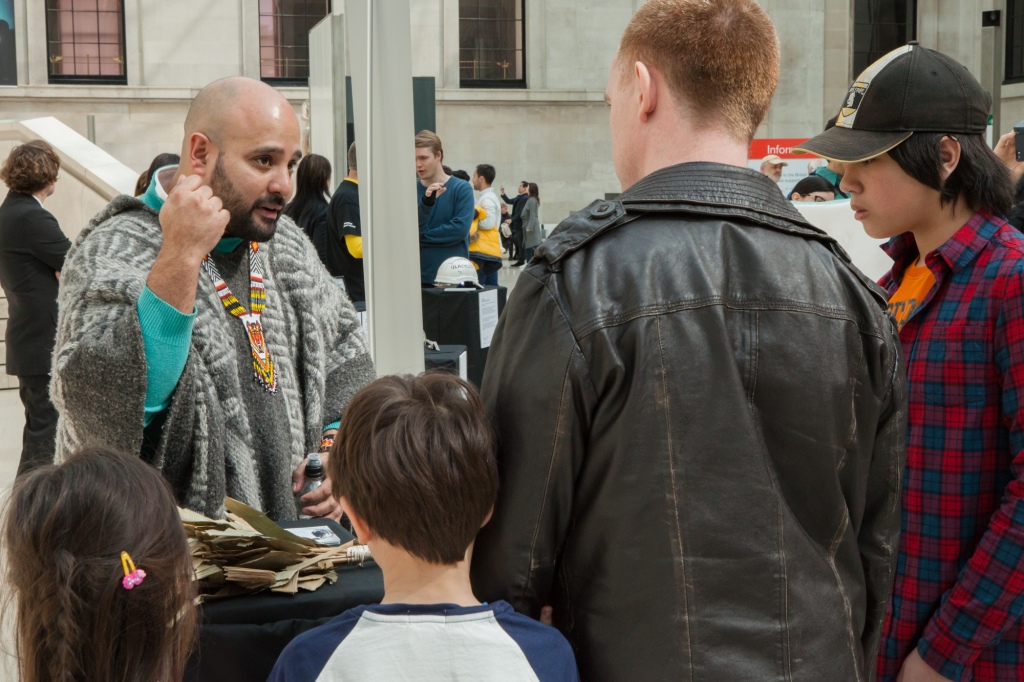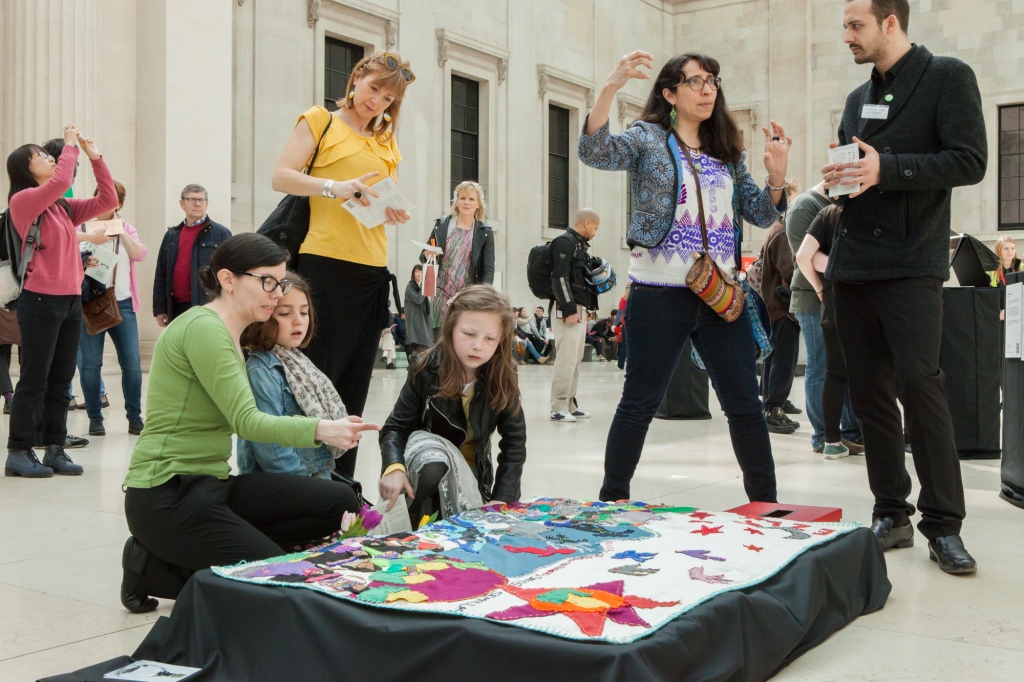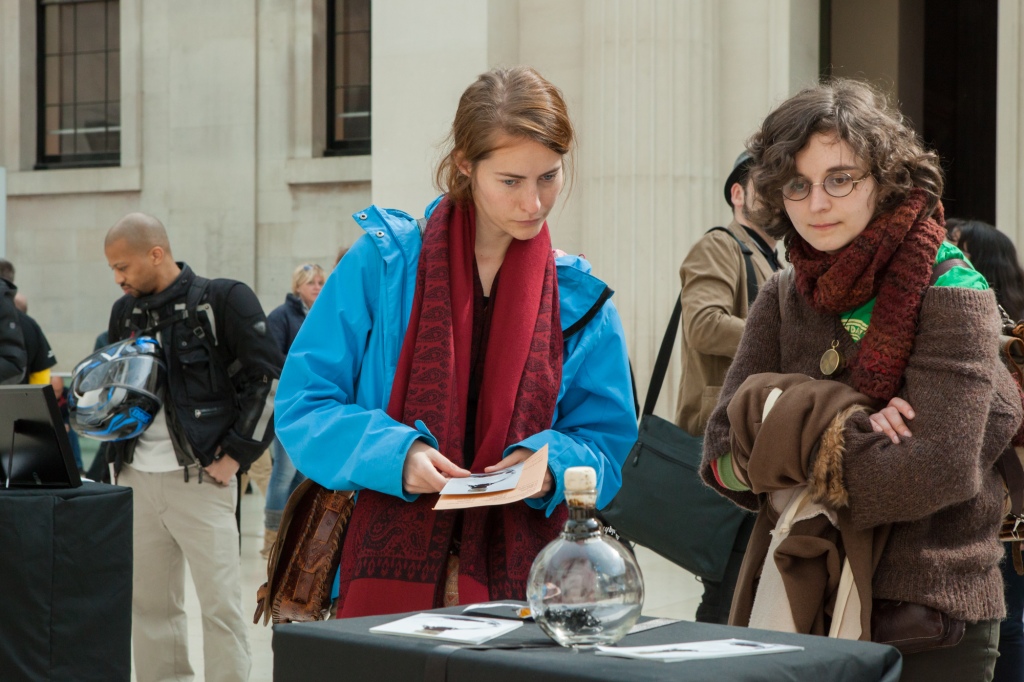Today is the first day at work for the British Museum’s new director, Hartwig Fischer. One of his first big challenges will be to decide whether to drop BP as a sponsor. We decided to give him a proper welcome…
Firstly, we took over the Great Court of the British Museum with a ‘disobedient exhibition’ about the Museum’s notorious sponsor, BP. Twenty of us arrived at 11am yesterday and set up the exhibition – called ‘A History of BP in 10 Objects’ – without permission, inside the iconic space.
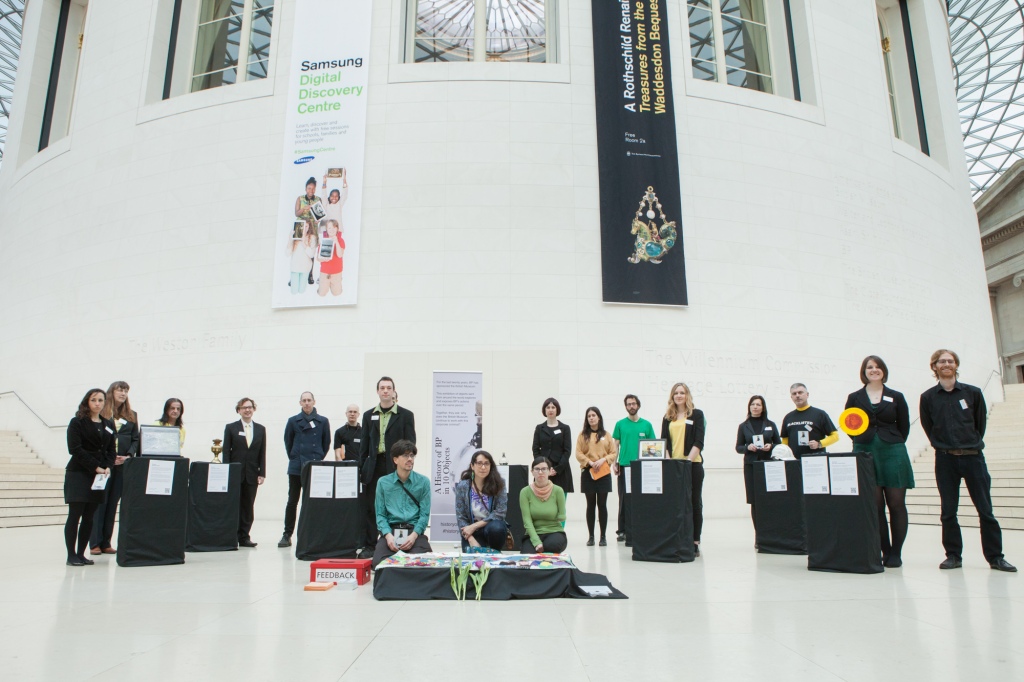 Our rebel exhibition sets up in the Great Court of the British Museum. All photos on this page by Amy Scaife
Our rebel exhibition sets up in the Great Court of the British Museum. All photos on this page by Amy Scaife
The exhibition featured objects sent from all over the world by communities impacted by BP’s environmental destruction and human rights abuses, including crude oil from the Gulf Coast spill, an empty tear gas cartridge from Tahrir Square and a shamanic healing tool from Colombia. You can see all the objects – including images, films and explanations – at our dedicated website www.historyofbp.org.
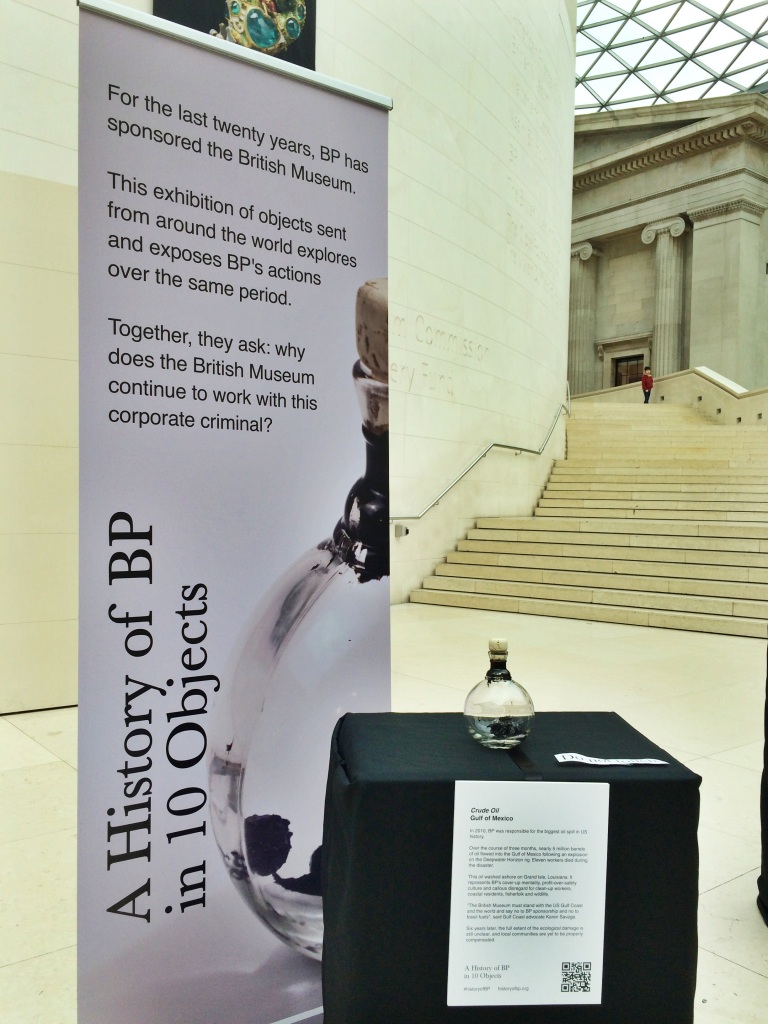 As well as artifacts directly linked to BP, the exhibition also includes items linked to the broader issue of corporate influence within public arts and culture. Objects have been donated by the museum workers’ union PCS, to highlight the growing threat of museum privatisation, and from construction workers whose names were held on an illegal blacklist by the Museum’s facilities contractor Carillion.
As well as artifacts directly linked to BP, the exhibition also includes items linked to the broader issue of corporate influence within public arts and culture. Objects have been donated by the museum workers’ union PCS, to highlight the growing threat of museum privatisation, and from construction workers whose names were held on an illegal blacklist by the Museum’s facilities contractor Carillion.
Our crew of ‘rebel curators’ gave tours and talks about the objects to hundreds of Museum visitors and staff, and used tablet devices to show films from the people who donated the objects, explaining their significance. We held the space – and our exhibition – until the Museum closed at 5.30pm. While we were in there, the second part of Hartwig’s welcome appeared in the Guardian: a letter, coordinated by the Art Not Oil coalition, from 91 famous and well-respected figures from across society. The signatories – including Mark Ruffalo, Margaret Atwood and Emma Thompson – are calling on Dr Fischer to end the Museum’s relationship with BP.
This combination of unexpected exhibition and celebrity letter got us a full page in the Guardian today, as well as coverage in the Telegraph, Artlyst, Huffington Post and elsewhere.
Today, we need your help with part three of Hartwig’s welcome: a petition asking him to drop BP, launched today with 38 Degrees. Please sign and share!
Fourthly, we will soon be presenting the objects from our guerrilla exhibition to the Museum as a gift to the nation. Museum trustees will then be required to consider whether to accept the objects into the collection.
The Museum’s 5-year deal with BP expires this year. Despite the high-profile nature of the BP sponsorship, it represents just 0.8% of the Museum’s annual income, or two hours’ profit for the oil giant. Last month, Tate announced that its 26-year relationship with BP was coming to an end, a decision that has increased the pressure on other oil-funded institutions to follow suit.
Cherri Foytlin, a Gulf Coast resident who submitted this powerful film for the exhibition, said: “Since 2010, there are a lot more graves in the Gulf of Mexico than there were before, and that’s just the truth. So anytime we see arts organisations take on BP as a sponsor, we want to make sure those institutions understand that they are sponsoring death. They are sponsoring death in our communities.”
Benny Wenda, West Papuan Independence Leader, who submitted a Morning Star flag to the exhibition, said: “I give this flag on behalf of my people of West Papua who continue to suffer and die under illegal occupation and genocide fuelled by BP. We West Papuans have witnessed our sacred lands destroyed by multinational corporations just to make more profit for the Indonesian government. While we West Papuans are imprisoned for 15 years just for raising our national flag, you have the freedom to speak out.”
Jess Worth from BP or not BP? said: “The objects in this exhibition show that BP is a menace to local people and ecosystems all over the world. The British Museum is supposed to help us understand and learn from history. Instead it continues to promote one of history’s most notorious corporate villains. Hartwig Fischer’s first big challenge will be to end the museum’s controversial contract with BP.”
Exhibition summary:
For the last twenty years, BP has sponsored the British Museum. Over the same period, it’s been linked to countless human rights and environmental abuses, while pursuing a business plan which makes climate breakdown inevitable.
This exhibition brings together objects sent from communities around the world and asks: why does the British Museum continue to work with this corporate criminal?
List of Objects:
- Crude oil from the Louisiana coastline following the BP Deepwater Horizon spill
- Lamassu charm from Iraq, where BP encouraged the Western invasion and is now operating
- Photo of Colombian trade unionist Gilberto Torres, who is currently suing BP for its role in his kidnap and torture
- Flag of independence from West Papua, where BP is supporting Indonesia’s repression of the West Papuan people
- Tear gas cartridge from Tahrir Square, Egypt, where BP is the biggest foreign investor
- Arpillera embroidery from Mexican and Latin American solidarity groups in London
- Hard hat from blacklisted construction workers – the museum also works with blacklisting firm Carillion
- Black confetti from Liberate Tate, used to celebrate Tate and BP parting company this March
- Oil lamp rescued from Calder Valley floods on Boxing Day 2015
- Waira Indigenous shamanic healing tool from Colombia
- Photo album of images from communities living next to BP’s Whiting refinery in Indiana
- Terms of Reference of Australian Senate inquiry over BP’s controversial plans to drill in the Great Australian Bight, sent by Bunna Lawrie, Indigenous Mirning Traditional Owner.
- Painted sunflower from No Privatisation at the National Gallery campaign by PCS Union members – the union, which also represents British Museum workers, is committed to ending oil sponsorship of culture
